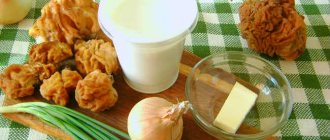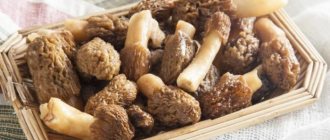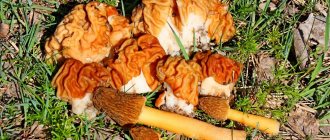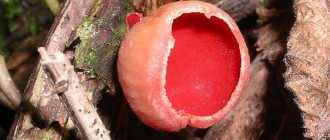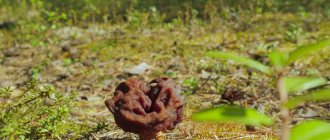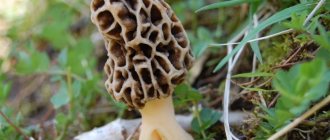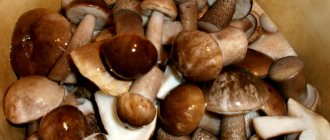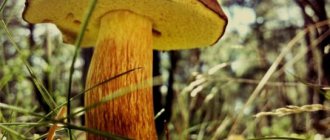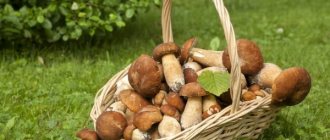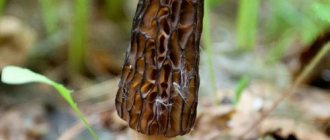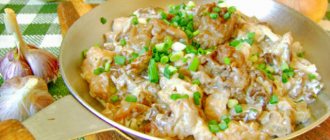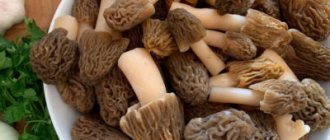Stitches and morels, similar in name and appearance, often cause confusion among novice mushroom pickers. Two early species of mushrooms germinate in forest belts and open areas from mid-spring. They can be detected as early as April. Usually, mushroom pickers go out for the first “silent hunt” by the 20th of April and continue collecting until the air temperature reaches 23-26 degrees. Fruiting of the mycelium lasts on average no more than three weeks.
Which family do they belong to?
Despite the frequent confusion in names, mushrooms can be distinguished not only by name and distinctive features, but also by classification. Strings belong to the genus of marsupials of the Discinaceae family. Morels are edible species of the morel genus, translated in Latin as Phallus esculentus. The unusual name is associated with the shape of the mushroom, visually reminiscent of the outlines of manhood.
Scientific information is, of course, useful, but not very important when collecting. It is much more important for a mushroom picker to find out the differences between morels and strings by studying whether they are edible or not, as well as visual photos of the differences that correspond to the classification of each family. The comparative description presented in the pictures will allow even a beginner to determine the difference when going fishing.
It has been scientifically proven that only morels can be eaten. It is better to avoid the lines in order to avoid poisoning and intoxication of the body. Due to statistics confirming a large number of poisonings, you should not risk your health and the well-being of your family and friends.
Use in cooking
Despite the confidence of many mushroom pickers in the safety of the stitch mushroom, it is not recommended to prepare the product without first drying it. Even conditionally edible species require heat treatment and drying at high temperatures for 90-120 days. Upon completion of drying, the product is ready for use as a spice or ingredient for first courses. Soups based on them turn out rich, tasty, and most importantly, low in calories.
For people without a sense of self-preservation, you can find various recipes for preparing the line on the Internet:
- salting and pickling for the winter;
- frying;
- stewing with cream or sour cream;
- combinations with potatoes in the oven.
Poisonous or edible?
Morels in Russia, Ukraine and Belarus are used as the main ingredient for various dishes. In the CIS countries and Europe, they are purchased for restaurants, as a gourmet delicacy. Their taste is famous for its unusual nutty aftertaste and is comparable to steamed chicken. Today, morels are classified as edible and conditionally edible mushrooms that germinate in the spring, after the snow melts and the first layers of soil warm up.
Strings are classified as poisonous mushrooms, with the exception of a few varieties that have conditionally edible status. They are consumed after long-term heat treatment, which includes: washing, cleaning from dirt with a brush, repeated boiling and draining of water.
The peculiarity of the lines remains the unique content of poison. It is noted that the more polluted the germination site and the less precipitation, the more poisonous the mushrooms can be. It is not for nothing that in European countries they are classified as prohibited and especially dangerous for consumption even after careful heat treatment. Quite a few cases of poisoning and deaths have been recorded.
The poison of the lines is gyromitrine. Its distinctive feature and main fame is the preservation of the mushroom product in the pulp even after boiling. It doesn’t matter at all how many times the cook boils the lines and changes the water, the poison contained in the pulp will remain.
Useful properties and value
The lines, despite their toxicity, also contain useful vitamins and microelements necessary for the proper functioning of the body. The pulp of conditionally edible species contains a high content of vitamins: groups A and B, PP. Speaking about micro- and macroelements, there is a great content:
- sodium;
- potassium;
- copper;
- phosphorus;
- manganese;
- calcium;
- magnesium
A similar set of benefits, collected together, has a beneficial effect on the condition of nails, vision and hair. With constant consumption, even in small quantities, there is an improvement in the functioning of the heart and blood vessels, gastrointestinal tract and nervous system. It is noted that immunity is boosted and metabolism is increased.
The pectin contained in the pulp has a beneficial effect on intestinal motility. Chitin is aimed at saturating the body and long-term dissolution of the pulp in the stomach. There are no more than 25 kcal per 100 g of product. There is more water in the lines than other additives.
What is the difference between morels and lines? Photo differences
Distinctive features help to remember not only the names of mushrooms, but also to preserve life after collection. Eating edible fruits and avoiding poisonous ones will allow you to collect a full basket of useful forest harvest, containing a lot of usefulness necessary for the full functioning of internal organs.
There are many charts available online that demonstrate the distinguishing features. In today’s article we will try to evaluate the difference without it, resorting not only to the characteristics of each type, but also to a photo example.
Many novice hunters, having seen the cap of both families, stop wondering what it looks like. In morels, it is more elongated, resembling a cone shape. It has holes, visually comparable to a dried, wrinkled sponge. Stitch caps are more unusual, comparable to oriental headdresses, which have rounded, slightly stretched outlines. Compared to the stem, the cap has a dominant size.
Considering the size of the cap, we can say that both mushrooms do not have a gigantic diameter. However, the size of the morel cap is several times smaller than the lines reaching 20 cm.
The fruiting body of morels is hollow or, one might say, whole. The pulp is snow-white, less often milky, and is fragile. The lines have separate cavities and unevenly growing pulp. When pressed, the mushroom breaks easily.
The stem of morels is white, cream-colored, and belongs to the fine-grained variety. It does not exceed 11-12 cm in height. In circumference, it can reach 6-7 cm. Fully visible on the surface. Grows exclusively on moist surfaces: pine needles, moist soil or moss. The stitches are the opposite; the leg has a short length. Often, the hat practically hides it. It germinates normally on moist soil.
The design on the hat, although similar, is different. The first ones are covered with deep cells that differ in size. The second ones resemble uneven strips connected together. If you look at the mushroom for the first time from afar, the lines will resemble the structure of the brain or the core of a pine nut.
The color scheme of the cap varies. Morels, unlike stitches, can be painted in light tones of yellow and brown, or resemble the shade of wet asphalt. The lines are brighter, often in brown or brown tones.
The aroma of morels is associated with edibility. Mushroom notes are felt both raw and cooked. The lines rather repel use. The aroma of dampness, reminiscent of a swamp, can hardly be tasty and attractive.
Stitches for the winter: recipes
All mushrooms have one significant drawback - they spoil quickly. Therefore, the problem of how to properly preserve the product is acute. The lines are dried, frozen, pickled, salted. There are many recipes, all interesting. Let's get acquainted.
Drying
Dry the lines whole. Choose healthy, fresh mushrooms, and after drying they become safe, more saturated, retain the smell of fresh mushroom for a long time, but decrease in size by five times. Use a clean cloth to remove moss, pine needles, dirt, and remaining soil.
Do not wash before cooking, otherwise the process will drag on for a long time, and the workpiece will darken. They are not pre-cooked; all toxic substances evaporate during drying.
There are many drying options. They take a long time to prepare, but they turn out very tasty when dried in the fresh air. The traditional recipe requires the presence of a Russian oven. Can be dried quickly in a gas or electric oven:
- Before drying in the fresh air, bait the mushrooms with fishing line, thick thread or wire. In order for the process to go quickly, perform it only in dry and hot summer time. It will take at least a week. Hang the prepared mushrooms in sunny places; you can cover them with gauze from flies. Be careful that the mushrooms do not touch.
- To cook in the oven, spread the mushrooms in a thin layer on a wire rack. It is desirable that the temperature rises gradually, the products are dried, but not cooked. The optimal temperature at the beginning of the process is 40 degrees, gradually increasing, but not more than 70 degrees. To ensure the required circulation, open the door slightly.
- Readiness is determined by palpation. They should be a little elastic, easy to break, but not crumble, and light in weight. Overdried ones become tasteless and lose their smell. Unprepared ones will become moldy and will not store well. If this happens, sort through, throw away the spoiled ones, and dry the rest.
Small mushrooms will be the first to reach readiness; select them as they are ready. Store in dry glass jars with lids. Preference is given to dark, cool places.
Freezing
Mushrooms that have already been cleaned of dirt and boiled with salt are frozen. If desired, they can be fried with the addition of vegetable oil. Pack in plastic bags and place in the freezer. Storage temperature: -18 degrees.
Varieties of morels with photos, are they poisonous?
Unfortunately, stitches and morels differ not only externally, but also internally. The first ones are strictly forbidden to consume due to the poison content in the pulp, which is dangerous for the body. The latter can and should be used as food after heat treatment. Morel varieties include both edible and conditionally edible species that are acceptable for consumption.
No. 1 - common morel
The classic representative of its species is Morchella esculenta or the common morel. Its distinctive feature for many years has been the merging of the cap with the stem. A single form sets it apart from its peers.
Externally, the cap is ovoid, elongated in shape with cells of varying depths. The leg is light, closer to a snow-white shade, and can reach up to 12 cm in length. The hat is painted in any shade of yellow or brown, from light to dark.
Of the pests encountered during the period of mycelium germination, slugs and other crawling insects hiding in the flesh of the cap become more active. To prevent them from getting into food, after picking, the mushrooms are washed and soaked in salt water for one hour. The procedure gets rid of not only pests, but also dirt that has adhered during the germination period.
No. 2 - conical morel
Morchella conica remains a species of the morel family found in humid areas. The conical shape, combining the cap and the stem, was transferred to the name of the species. The morel is conical and stands out in the area for the following differences:
a hollow but cellular cap with a pointed shape, reaching a length of up to 10 cm, not counting the stem. Usually, the size of the upper part is larger than the lower part. The color scheme is light yellow, with a slight tint of brown. In rare cases, it can be colored to dark brown;
the leg is cylindrical, empty inside. The height is small, in rare cases reaching 6 cm. The diameter does not exceed 1.5 cm. Externally, it is covered with velvet coating and longitudinal grooves. The color scheme is white, less often light yellow.
No. 3 - tall morel
A large morel, similar to a conical one, has the unusual name Morchella elata. Translated into Russian, it is characterized as high. The difference between the species remains the dark shade of the cap and the large, one might even say tall, fruiting body. The length of the “high” reaches up to 35 cm.
The hat resembles a cone, reaching a length of up to 12 cm and a diameter of no more than 2.5. On the top of the mushroom you can see deep cells. The color scheme is red, less often brown with a black tint. The partitions between the cells are expressive, differing in color from the fruit itself. They often have an olive-red tone.
The leg is tall, slightly longer than the cap. It can be an elongated white shape, no more than 16 cm. In adult mushrooms it can be darker, from cream to light coffee shade.
No. 4 - steppe morel
The name speaks for itself! Morchella steppicola, or popularly known as the largest morel (photo below), is found throughout almost the entire territory of Russia. It can be found in April and May on vast steppes, fields, swampy areas and even forest belts where moss sprouts.
The hat is similar in roundness to the stitch, but has a soft creamy tint. It can reach up to 25 cm in width and height.
The leg is snow-white, short and empty. The height in rare cases reaches 2.5 cm.
In order not to confuse the steppe morel with a line that is poisonous or conditionally edible, it is recommended to navigate not only by the signs, but also by a visual photo. With a correct visual assessment of the differences, even a beginner will be able to identify an edible mushroom from a forbidden one that is not recommended for collection.
Champignons and toadstools
Spring mushrooms are often confused with toadstools. Visually, they have a lot in common, so in order not to make a mistake, before cutting the mushroom, check the color of the cap - the plates on the lower surface should be pink. In the toadstool they are completely white.
Champignon:
Photo source: TV channel “360”
White grebe:
Photo source: TV channel “360”
Varieties of stitches, from conditionally edible to poisonous
Strings, like all mushrooms, have varieties, and most importantly, they differ not only in edibility, but also in external criteria. On the territory of Russia, the following species are most often found:
No. 1 - ordinary stitch
The traditional representative of the species or gyromitra esculenta, quite rarely germinates in the forest belt. Myceliums most often form in open areas rich in sandy soil. Fruiting occurs at the end of March and continues until mid-May.
The hat is medium-sized, reaching no more than 25 cm in width. The shape is round, not quite even, colored in a chestnut shade. Less commonly, it may be dark brown.
The leg is elongated, hidden more than half in the ground. Its height rarely exceeds 10 cm, and its width - 8 cm. It is often flattened, empty from the inside.
The aroma is moderately mushroomy and can confuse the mushroom picker, deceiving his gullibility.
No. 2 - giant line
The large-fruited mushroom, or gyromitra gigas, has an external outline resembling the shape of a brain. The sinuous pattern on the large cap and short stem indicates the conditional edibility of the mushroom.
The hat has an unusual pattern, similar to the kernel of a pine nut. The cavity is empty, uneven, round in shape. Differs in the presence of folds. The color scheme is dirty yellow, less often red. The width can reach 65 cm.
The leg is extremely short, no higher than 4 cm. In a humid environment, it is often hidden in the ground. Color - snow-white. It's always empty inside.
Compared to other varieties, giant stitches can be eaten after prolonged heat treatment. Their pulp contains the minimum amount of gyromitrin permissible for humans after boiling. Of course, not all mushroom pickers agree with this opinion. Experienced mushroom lovers avoid any lines, trying to choose only proven mushrooms that belong to edible species.
You can find a giant line in the spring in the planting of birch trees. Compared to other varieties, its structure is larger, and the cap is light, closer to a yellow tone. The aroma is quite pleasant, reminiscent of lines.
No. 3 - autumn line
Despite its relation to early mushrooms that germinate in spring, gyromitra infula or autumn stitch is popularly considered horn-shaped due to its unusual structure. The mushroom cap resembles the horns of an animal, reaching a length of more than 10-12 cm. There are folds. The color scheme of young mushrooms is light brown, becoming darker with age. The lines that grow in autumn have 2-3 horns, connected together, as if fused. The coating is velvety to the touch, reminiscent of noble fabric.
The length of the leg varies from 4 to 11 cm. The width is no more than 2 cm. The inside of the mushroom is empty and slightly flattened. The color scheme can be white, grayish or light brown. The shape is cylindrical.
When pressed, the mushroom crumbles. The fragile pulp once again proves that the lines are not worth collecting due to their high toxicity. It is preferable to choose conditionally and edible mushrooms that germinate from late June to early September.
Morels, where do they grow in 2022?
Morels can be found not only in forest belts, but also in open areas: fields, meadows, near rivers and swamps, plantings. All varieties get along better in damp areas where moss grows or there is coniferous litter.
Photos in the Moscow region and Leningrad
Often, experienced mushroom pickers go hunting in aspen trees. In Central and Central Russia, their number has increased to the maximum.
The conical morel can be found in pine forests, where both young and old trees grow. Less commonly, the variety can be found in deciduous plantings: birch, aspen, oak groves. Most often, the mycelium takes root in clearings and fields located in the shady zone.
The morel cap loves the sun's rays, appearing later than its fellow tribesmen from the beginning of May. Germination occurs in garden plots, forest paths and even burnt areas. You can meet them after heavy rains.
The gray giant morel is one of the most unpretentious. It can grow in any area, regardless of the climatic characteristics of the region, weather and soil. Most often found near poplars.
To detect morels, you should remember the necessary germination conditions:
- a sufficient amount of moisture remaining in the first months of spring, as well as near rivers and swamps;
- germination occurs from April to May, until the air temperature exceeds 23-25 degrees during the daytime;
- fruiting lasts no more than 3 weeks;
- It is better to look for a good harvest after rain in a deciduous or mixed forest.
Important!
The morel mushroom bears fruit for a short time. All mushroom pickers know that it can only be detected between April and May, while the upper layers of the soil are saturated with melt water. As soon as the soil dries out, the forest harvest disappears. Fruiting occurs once a year.
Despite the short fruiting period, the yield can reach maximum levels. If warm but rainy weather comes to the region, you can collect baskets full of mushrooms. The small size of morels will allow you to prepare both first and second courses, preparations for the winter and even freezing for winter use.
Why don't many mushroom pickers collect morels? The answer lies in its repulsive appearance. In comparison with porcini, Polish mushrooms and obabkas, morels do not attract attention from the outside, and sometimes even seem foreign.
It is impossible to confuse edible morels with dangerous stitches! Differences in appearance are fundamental criteria in distinguishing two different families. The video below demonstrates the distinctive features:
Use of stitch mushroom in medicine
String is a mushroom that is often used not only in cooking, but also in folk medicine. The first spring mushrooms are used as medicine to treat a number of diseases:
- radiculitis;
- myositis;
- eye diseases;
- rheumatism;
- osteochondrosis;
- arthritis;
- rheumatism.
An alcohol tincture is made from the fruits and used for rubbing external surfaces. To prepare the miracle remedy, use 50 g of dried stitches and 0.7 liters of medical alcohol, diluted to 45-50% with boiled water. After stirring, the resulting mixture is covered with a nylon lid and placed in the refrigerator for 3 weeks. After time, the infusion is used for rubbing and alcohol compresses. For the desired effect, the place where the mushroom infusion is applied is wrapped in a woolen scarf.
The second recipe involves adding melted honey to the alcohol tincture. For 700 ml of diluted alcohol, take 7 tablespoons. l. natural honey. After a few weeks, the solution is used for rubbing and compresses. 30-40 minutes after the procedure, the area is washed with warm water and wiped dry, covered with warm material.
Lines where to grow in 2022?
Years go by, but the gathering places do not change. Like morels, stitches can be found in almost any forested area, plantings of birch and aspens, open fields and meadows. Less commonly, mushrooms are found near swamps and rivers, where water nourishes the soil, maintaining high humidity for several weeks longer.
In Crimea and Kuban
Like morels, morels sprout in different places, depending on the variety. Some prefer pine forests, coniferous plantings and clearings. This applies in particular to the giant line. But the “autumn” one prefers deciduous and mixed zones, open areas adjacent to the river mouth.
Is it possible to get poisoned by lines?
Our line has a bad reputation (and sometimes it also applies to morels). There were, they say, cases of poisoning. At first it was believed that the problem was some kind of poisonous gelvelic acid (its name comes from one of the mushrooms of the family - gelvels: perhaps in September-October you came across this unsightly mushroom on a thick gray stalk - it is sometimes mistaken for a line that came from nowhere in the autumn) . This version was not confirmed, and then a new culprit was appointed - the toxin gyromitrin, named after the Latin name of the line.
Morels do not seem to contain gyromitrin (in any case, research by the English scientist R. J. Benedict points to this), but the label of a suspicious mushroom has not been removed from it. Almost any book that admits that morels can be eaten talks about the need for preliminary heat treatment. Such recommendations can reach the point of absurdity - for example, one recently published cookbook suggests boiling morels for an hour before cooking, and then, of course, draining the water. Interesting: every spring I collect, cook and eat these mushrooms - and for many years now I have limited myself to simply washing them with running water and then stewing them. True, I collect morels in a certain place - the southern Ladoga region. I won’t vouch for other regions - you never know what excellent mushrooms can mutate into under the influence of poor ecology. See for yourself. But do not forget that by boiling the morels once again, along with the water you will pour that unique aroma of the forest awakening from hibernation into the sink.
Morels and lines, taste
Two separate families with similar names differ in appearance and have different aroma. However, the taste of the products is similar. Refined soft mushroom pulp is not comparable to the popular honey mushrooms and even noble mushrooms. In Europe, morel fruits are used as a delicious ingredient for preparing various dishes. Just like truffles, their taste and aroma are valued by gourmets.
Morels are used to prepare various dishes. However, the most popular remain fried mushrooms with onions and meat fillet, as well as stews in sour cream sauce.
The lines are no less tasty, but quite dangerous. In Germany, their collection is strictly prohibited! Numerous poisonings warn of detrimental harm to the body, both adults and teenage children over 14 years of age. Even conditionally edible varieties may not always be beneficial if you ignore the rules of heat treatment or collect the fruits in a contaminated place.
Fried
It is very easy to fry the products; they have an excellent aroma and high taste. The sequence is as follows:
- Boil the mushrooms in water with added salt for half an hour, drain the liquid and rinse the lines with plenty of water. You can rinse with liquid and soak for half an hour in a solution of 1 teaspoon of salt and vinegar per 1 liter of water.
- Place the chopped mushrooms in a heated frying pan with sunflower oil. Fry a little.
- Peel the onion, cut into small pieces of any shape. Add to mushrooms. Continue frying until golden brown.
- Cover with a lid and cook for another 20 minutes.
- Serve with chopped herbs and lettuce leaves.
Cooking morels and strings, recipes for heat treatment at home
The recipes of the two families are different. Some do not require long-term heat treatment before preparing the dish you like at home, while others, on the contrary, without double boiling, become no less dangerous than their poisonous counterparts. For proper preparation, in addition to the recipe, in the preparation of stitches, it is recommended not to forget about the rules of heat treatment: including:
- the washing up;
- soaking in salted water;
- boiling carried out repeatedly, with the broth drained.
Morels must be soaked in salt water for one to two hours. Such manipulation rids the fruit of contamination and slugs hiding inside the hat. Upon completion, the mushrooms are boiled, adding onion rings to the water to give the fruits a bright aroma. As soon as the heat treatment is complete, begin preparing the dish you like:
- morels with sour cream and onions;
- morels with cream according to the technological map;
- salted morels recipe;
- with potatoes fried in a frying pan;
- morels with eggs and pasta;
- recipes with meat;
- recipe from Yulia Vysotskaya;
- preparation for the winter: fried in jars, pickled and salted.
Lines used for consumption are only conditionally edible. Poisonous fruits are avoided due to the toxicity that persists even after heat treatment. After washing, soaking and repeated boiling, the water is drained each time and the preparation of the main dish begins. Most often it is preserved for the winter, less often - a second course.
The most popular recipes with lines:
- with potato;
- with sour cream;
- with cream;
- preparation for the winter, salted or fried.
Stitch soup
To prepare soup from half a kilogram of mushrooms, you need to take one onion, greens, 300 g of potatoes and just a little pearl barley or wheat. And pre-prepare the lines themselves to remove carcinogenic substances as indicated above. Next we continue according to the scenario:
- Pour water into a small saucepan and place on fire. After boiling, add chopped mushrooms. Cook for 20 minutes.
- Peel the potatoes and cut into pieces. Place in broth, add cereal and salt. Cook until the potatoes are done.
- Heat a frying pan, pour in a little vegetable oil.
- Peel the onion, cut into pieces and fry.
- A few minutes before turning off, add chopped herbs and fried onions. Boil for a few minutes.
Read about how to make delicious dried mushroom soup here.
